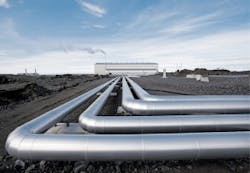Guest Commentary: Financing Infrastructure Upgrades Becoming Faster and Easier
When a small town in New York found it was in need of a new fire truck for its volunteer fire department last year, the only question was how to pay for it. The same was true for a Seattle-area housing authority that was interested in growing its inventory of affordable and workforce housing. For both of these organizations, the answer turned out to be straightforward: a tax exempt financing structure from the bank, which provided the funding needed for the capital investment while also offering stability, flexibility, and overall cost savings.
As the cost of upgrading and maintaining an outdated water infrastructure continues to climb, many utilities also lack the funds needed to invest in necessary capital equipment. In fact, according to the American Water Works Association’s (AWWA) 2014 State of the Water Industry Report, financing capital projects is the third most pressing issue facing water professionals today, with the condition of the water and wastewater infrastructure at the top of the list of concerns.
Fortunately, the financing options available for water infrastructure investments are becoming faster, easier, and more accessible to municipal water districts. Although bond financing remains the most common way to cover the cost of upgrading equipment, the more cost effective but lesser-known option of traditional bank financing, commonly known as “installment purchase financing,” is proving to be an easier way forward for some.
THE BENEFITS ADD UP
Although bond financing has been an effective way for water utilities to fund new or upgraded equipment, it can be time consuming and intimidating, especially for smaller municipalities. To help meet the need for easier, more flexible financing for water infrastructure expenditures, banks are starting to integrate some of the key components of bond financing into more traditional equipment financing structures to meet the specific needs of water utilities.
These agile hybrid finance arrangements provide aggressive tax-exempt rates for municipal water districts, can be customized to meet the specific budgetary requirements of a particular utility, and can accomplish this without the reams of paperwork that accompany a typical bond issue. These structures may entail funding provided directly from an equipment manufacturer/vendor or the bank. This also offers the added value of working one-on-one with a lender who can deliver guidance and advice throughout the process.
Installment purchase structures can be used to cover the full scope of equipment and technology needed by water utilities, including everything from water meters and pumps to supervisory control and data acquisition (SCADA) solutions and billing systems. In addition to the cost of equipment, traditional financing can also cover the “soft costs” of an equipment acquisition, which means utilities can plan for one predictable monthly payment that covers the cost of the equipment and the subsequent installation, service, training, and support fees.
Other benefits of installment purchase financing for municipal water districts include:
LESS PAPERWORK
While typical bond issues can be 200–300 pages long, an installment purchase agreement is typically between 20–30 pages. This means less time spent reading and approving documentation and more time serving customers.
ELIMINATE COST OF ISSUANCE (COI)
Installment purchase agreements help save water utilities money by eliminating all fees associated with the COI. This means no fees for insurance companies, trustees, borrower’s and lender’s council, and Escrow agents.
SPEED
Putting together a bond and getting all necessary approvals—and in some cases voter approval—can take anywhere from 90 days to six months. With installment purchase financing, applications are typically approved within two weeks.
FLEXIBILITY
With installment purchase financing, it’s easy for water utilities to add or upgrade equipment to meet the demands of population growth. Typically, the bank will add a “schedule” to an existing finance agreement, which means approximately 90% of the paperwork required is already complete from the initial transaction. Once again, this provides a faster, cheaper, and easier alternative to bond financing, which would require starting from square one to obtain the funds to cover the additional equipment needs.
DEBT COVERAGE RATIO
Like bond financing, installment purchase financing can include a rate maintenance covenant. By building into the agreement a reasonable debt coverage ratio (or “additional debt test”), which is less onerous than that contained in typical bonds, both the investor and borrower benefit. The investor gains comfort with regard to future borrowings, and the borrower receives a better rate reflective of that comfort.
DEBT SERVICE RESERVE
In certain instances, a debt service reserve (DSR) fund of 10% or less of the total acquisition may be established. Escrowed and held for the borrower, this reserve can help a challenged credit gain approval by providing a means with which to help cover the cost of the lease payment in case of emergency. The DSR is then replenished by the borrower prior to the next payment due date unless other arrangements are made. In addition, this credit “cushion” can also help a utility weather an extraordinary or unforeseen financial event and provide an adequate window for adjustment and recovery.
END OF TERM OPTIONS
Water utilities have several options at the end of the financing arrangement. While traditional tax-exempt qualifying structures will typically be used, other options can allow for important alternatives in certain situations. Depending on the specific details of the finance agreement, at the end of a lease purchase agreement the municipality can either purchase the equipment at the fair market value, renew the finance agreement at a fixed price, or choose a $1 purchase option. This flexibility offers more alternatives for asset management in terms of acquisition, replacement, and renewal.
SELECTING A PARTNER
Installment purchase financing, while used on a daily basis in other government sectors, is an option which not all banks offer when discussing options for water utilities. When searching for a finance partner, look for a company that is experienced working with water utilities. You should also look for a finance partner that:
- is flexible and willing to work with you to develop a program that will meet your financial objectives;
- considers the relationship a partnership and is readily available to answer questions and provide support throughout the life of the agreement;
- offers fast credit approvals and quick, easy processing;
- and is a financially stable, long-term business partner.
Just as innovations in technology are making water utilities more efficient, so too are innovations in finance. Today’s more nimble options combine the most important benefits of bond financing with a faster, easier, and less costly solution similar to that used for other types of tax-exempt equipment upgrades. Because after all, finding the funds for the water infrastructure should be as easy as it is for the fire truck.
Brian DePonte is senior vice president of innovation markets at Key Equipment Finance. He has nearly 20 years of experience in water infrastructure financing and leads a team dedicated to meeting the equipment finance needs of this market.


